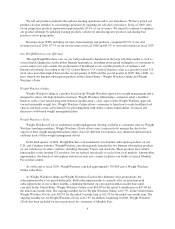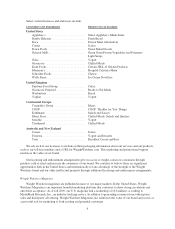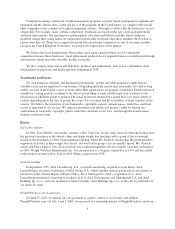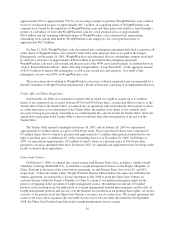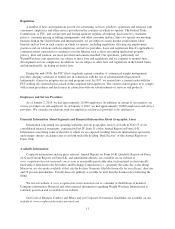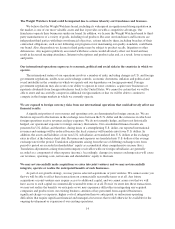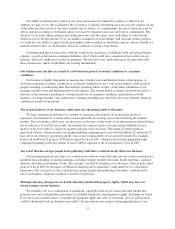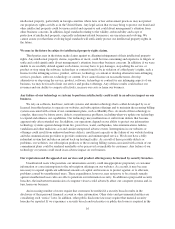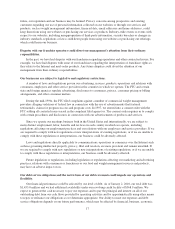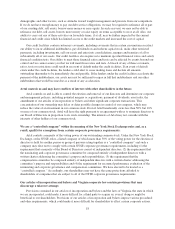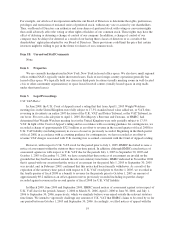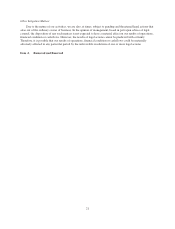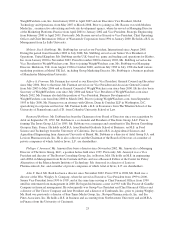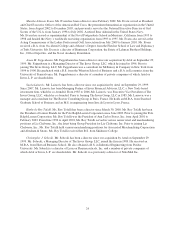WeightWatchers 2009 Annual Report Download - page 30
Download and view the complete annual report
Please find page 30 of the 2009 WeightWatchers annual report below. You can navigate through the pages in the report by either clicking on the pages listed below, or by using the keyword search tool below to find specific information within the annual report.The Weight Watchers brand could be impaired due to actions taken by our franchisees and licensees.
We believe that the Weight Watchers brand, including its widespread recognition and strong reputation in
the market, is one of our most valuable assets and that it provides us with a competitive advantage. Our
franchisees operate their businesses under our brand. In addition, we license the Weight Watchers brand to third-
party manufacturers of a variety of goods, including food products. Because our franchisees and licensees are
independent third parties with their own financial objectives, actions taken by them, including breaches of their
contractual obligations, such as not following our program or not maintaining our quality standards, could harm
our brand. Also, the products we license to third parties may be subject to product recalls, litigation or other
deficiencies. Any negative publicity associated with these actions would adversely affect our brand and may
result in decreased meeting attendance, Internet subscriptions and product sales and, as a result, lower revenues
and profits.
Our international operations expose us to economic, political and social risks in the countries in which we
operate.
The international nature of our operations involves a number of risks, including changes in U.S. and foreign
government regulations, tariffs, taxes and exchange controls, economic downturns, inflation and political and
social instability in the countries in which we operate and our dependence on foreign personnel. Foreign
government regulations may also restrict our ability to operate in some countries, acquire new businesses or
repatriate dividends from foreign subsidiaries back to the United States. We cannot be certain that we will be
able to enter and successfully compete in additional foreign markets or that we will be able to continue to
compete in the foreign markets in which we currently operate.
We are exposed to foreign currency risks from our international operations that could adversely affect our
financial results.
A significant portion of our revenues and operating costs are denominated in foreign currencies. We are
therefore exposed to fluctuations in the exchange rates between the U.S. dollar and the currencies in which our
foreign operations receive revenues and pay expenses. We do not currently hedge, and have not historically
hedged, our operational exposure to foreign currency fluctuations. Our consolidated financial results are
presented in U.S. dollars and therefore, during times of a strengthening U.S. dollar, our reported international
revenues and earnings will be reduced because the local currency will translate into fewer U.S. dollars. In
addition, the assets and liabilities of our non-U.S. subsidiaries are translated into U.S. dollars at the exchange
rates in effect at the balance sheet date. Revenues and expenses are translated into U.S. dollars at the average
exchange rate for the period. Translation adjustments arising from the use of differing exchange rates from
period to period are recorded in shareholders’ equity as accumulated other comprehensive income (loss).
Translation adjustments arising from intercompany receivables with our foreign subsidiaries are generally
recorded as a component of other expense (income). Accordingly, changes in currency exchange rates will cause
our revenues, operating costs, net income and shareholders’ equity to fluctuate.
We may not successfully make acquisitions or enter into joint ventures and we may not successfully
integrate, operate or realize the anticipated benefits of such businesses.
As part of our growth strategy, we may pursue selected acquisitions or joint ventures. We cannot assure you
that we will be able to effect these transactions on commercially reasonable terms or at all. Any future
acquisitions or joint ventures may require access to additional capital, and we cannot assure you that we will
have access to such capital on commercially reasonable terms or at all. Even if we enter into these transactions,
we may not realize the benefits we anticipate or we may experience difficulties in integrating any acquired
companies and products into our existing business; attrition of key personnel from acquired businesses;
significant charges or expenses; higher costs of integration than we anticipated; or unforeseen operating
difficulties that require significant financial and managerial resources that would otherwise be available for the
ongoing development or expansion of our existing operations.
14


